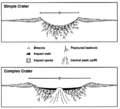Lawn Hill crater


Lawn Hill ‘crater’ refers to an impact structure, the eroded remnant of a former impact crater, situated approximately 220 km north-north-west of Mount Isa in northwestern Queensland, Australia. The site is marked by an 18 km diameter ring of dolostone hills. The origin of this circular feature was uncertain until the discovery of shatter cones and shocked quartz from uplifted rocks at the centre was reported in 1987.[1][2]
The site is heavily eroded and it has been suggested that the original crater was slightly larger, at around 20 km diameter.[3] The age of the impact structure is somewhat contentious, in the absence of any radiometric dating. The impact–shocked rocks at the centre of the site are early Mesoproterozoic in age, which gives an absolute maximum possible age for the impact. In the past it has been debated whether the limestones, which are of Middle Cambrian age (ca. 510 Ma) based on comparisons with nearby outcrops of marine limestone in the Georgina Basin, were simply deposited in the crater after its formation, or were actually deformed by the impact event.[4] Depending on the differing points of view, the crater may be of earlier Cambrian or Proterozoic age, or it could be of younger Paleozoic age. The most recent study concludes that the impact most likely happened just before or even during the early stages of deposition of the limestone, suggesting an age of around 509–506 Ma (Middle Cambrian).[5]
Based on the theory that the crater was invaded by the sea just after the impact, the crater may have formed a unique protected microenvironment for primitive life, and could be an important analogue to craters filled with sediment in a similar way on Mars.[5]
References
- ↑ Stewart A, Mitchell K (1987). "Shatter cones at the Lawn Hill circular structure, northwestern Queensland; presumed astrobleme". Australian Journal of Earth Sciences 34 (4): 477–485. Bibcode:1987AuJES..34..477S. doi:10.1080/08120098708729427.
- ↑ "Lawn Hill". Earth Impact Database. University of New Brunswick. Retrieved 2009-08-19.
- ↑ Shoemaker EM, Shoemaker CS (1996). "The Proterozoic impact record of Australia". AGSO Journal of Australian Geology & Geophysics 16: 379–398.
- ↑ Haines PW (2005). "Impact cratering and distal ejecta: the Australian record". Australian Journal of Earth Sciences 52 (4–5): 481–507. Bibcode:2001AuJES..52..481H. doi:10.1080/08120090500170351. Abstract
- ↑ 5.0 5.1 Lindsay J, Brasier M (2006). "Impact Craters as biospheric microenvironments, Lawn Hill Structure, Northern Australia". Astrobiology 6 (2): 348–363. Bibcode:2006AsBio...6..348L. doi:10.1089/ast.2006.6.348. PMID 16689651. Abstract
Coordinates: 18°40′01″S 138°37′48″E / 18.667°S 138.63°E

